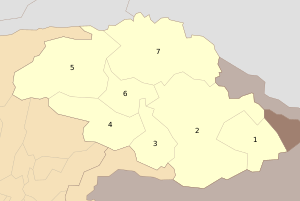Azad Kashmir
| Azad Jammu and Kashmir آزاد جموں و کشمیر Āzād Jammū̃ o Kaśmīr | ||||||
|---|---|---|---|---|---|---|
| Administrative Territory of Pakistan | ||||||
Top Left to Right: Neelam Valley, Leepa Valley, Toli Pir, Neelum–Jhelum Hydropower Plant, Neelam Valley and Muzafarabad | ||||||
| ||||||
.svg.png) Azad Jammu and Kashmir (AJK) is shown in red. Rest of Pakistan is shown in white and rest of Jammu and Kashmir is hatched showing area with Pakistan's territorial claim | ||||||
| Coordinates: 34°13′N 73°17′E / 34.22°N 73.28°ECoordinates: 34°13′N 73°17′E / 34.22°N 73.28°E | ||||||
| Country |
| |||||
| Established | Oct 24, 1947 (Azad Kashmir Day (یوم تاسیس)) | |||||
| Capital | Muzaffarabad | |||||
| Largest city | Mirpur | |||||
| Government | ||||||
| • Type | Self-governing state under Pakistani administration[1][2][3][4][5] | |||||
| • Body | Azad Jammu & Kashmir Legislative Assembly | |||||
| • President | Masood Khan | |||||
| • Prime Minister | Farooq Haider Khan (Pakistan Muslim League (N)) | |||||
| Area | ||||||
| • Total | 13,297 km2 (5,134 sq mi) | |||||
| Population (2008; est.) | ||||||
| • Total | 4,567,982 | |||||
| • Density | 340/km2 (890/sq mi) | |||||
| Time zone | PKT (UTC+5) | |||||
| ISO 3166 code | PK-JK | |||||
| Main Language(s) | ||||||
| Assembly seats | 49 | |||||
| Districts | 10 | |||||
| Towns | 19 | |||||
| Union Councils | 182 | |||||
| Website | www.ajk.gov.pk | |||||
Azad Jammu and Kashmir (Urdu: آزاد جموں و کشمیر Āzād Jammū̃ o Kaśmīr), abbreviated as AJK and commonly known as Azad Kashmir, is a self-governing[3] administrative division of Pakistan. The territory lies west of the Indian-administered state of Jammu and Kashmir, and was previously part of the former princely state of Jammu and Kashmir, which ceased to exist as a result of the first Kashmir war fought between India and Pakistan in 1947.
Azad Kashmir is part of the greater Kashmir region, which is the subject of a long-running conflict between India and Pakistan. The territory shares a border with Gilgit–Baltistan, together with which it is referred to by the United Nations and other international organisations as "Pakistan-administered Kashmir".[note 1] The territory also borders Pakistan's Punjab province to the south and Khyber Pakhtunkhwa province to the west. To the east, Azad Kashmir is separated from the Indian-administered state of Jammu and Kashmir by the Line of Control, the de facto border between India and Pakistan. Azad Kashmir has a total area of 13,297 square kilometres (5,134 sq mi), with an estimated population of around 4.6 million people.
The territory has a parliamentary form of government modeled after the Westminster system, with its capital located at Muzaffarabad. The President of Azad Kashmir is the constitutional head of the state, while the prime minister, supported by a Council of Ministers, is the chief executive. The unicameral Azad Jammu & Kashmir Legislative Assembly elects both the prime minister and president. The state has its own Supreme Court and a High Court, while the Government of Pakistan's Ministry of Kashmir Affairs serves as a link between it and Azad Kashmir's government. Neither Azad Kashmir nor Gilgit-Baltistan elect members to Pakistan's National Assembly.
The 2005 earthquake killed 100,000 people and left another three million people displaced, with widespread devastation. Since then, with help from the Government of Pakistan and foreign donors, reconstruction of infrastructure is underway. Azad Kashmir's economy largely depends on agriculture, services, tourism, and remittances sent by members of the British Mirpuri community. Nearly, 87% of the households own farms in Azad Kashmir,[10] while the region has a literacy rate of approximately 72% and has the highest school enrollment in Pakistan.[11]
History

At the time of the Partition of India in 1947, the British abandoned their suzerainty over the princely states, which were left with the options of joining India or Pakistan or remaining independent. Hari Singh, the maharaja of Jammu and Kashmir, wanted his state to remain independent.[12][13]
In Spring 1947, an uprising against the Maharaja broke out in Poonch, an area bordering the Rawalpindi division of West Punjab. Maharaja's administration is said to have started levying punitive taxes on the peasantry which provoked a local revolt and the administration resorted to brutal suppression. The area's population, swelled by recently demobilised soldiers following World War II, rebelled against the Maharaja's forces and gained control of almost the entire district. Following this victory, the pro-Pakistan chieftains of the western districts of Muzaffarabad, Poonch and Mirpur proclaimed a provisional Azad Jammu and Kashmir government in Rawalpindi on 3 October 1947.[14][note 2] Khwaja Ghulam Nabi Gilkar, under the assumed name "Mr. Anwar," issued a proclamation in the name of the provisional government in Muzaffarabad. However, this government quickly fizzled out with the arrest of Anwar in Srinagar.[16] On 24 October, a second provisional government of Azad Kashmir was established at Palandri under the leadership of Sardar Ibrahim.[17]
On 21 October, several thousand Pashtun tribesmen from North-West Frontier Province poured into Jammu and Kashmir to liberate it from the Maharaja's rule. They were led by experienced military leaders and were equipped with modern arms. The Maharaja's crumbling forces were unable to withstand the onslaught. The raiders captured the towns of Muzaffarabad and Baramulla, the latter 20 miles (32 km) northwest of the state capital Srinagar. On 24 October, the Maharaja requested military assistance from India, which responded that it was unable to help him unless he acceded to India. Accordingly, on 26 October 1947, Maharaja Hari Singh signed an Instrument of Accession, handing over control of defence, external affairs and communications to the Government of India in return for military aid.[18] Indian troops were immediately airlifted into Srinagar.[19] Pakistan intervened subsequently.[13] Fighting ensued between the Indian and Pakistani armies, with the two areas of control more or less stabilised around what is now known as the "Line of Control".[20]
India later approached the United Nations, asking it to resolve the dispute, and resolutions were passed in favour of the holding of a plebiscite with regard to Kashmir's future. However, no such plebiscite has ever been held on either side, since there was a precondition which required the withdrawal of the Pakistani Army along with the non-state elements and the subsequent partial withdrawal of the Indian Army.[21] from the parts of Kashmir under their respective control – a withdrawal that never took place.[22] In 1949, a formal cease-fire line separating the Indian- and Pakistani-controlled parts of Kashmir came into effect.
Following the 1949 cease-fire agreement with India, the government of Pakistan divided the northern and western parts of Kashmir that it occupied at the time of cease-fire into the following two separately-controlled political entities:
- Azad Jammu and Kashmir (AJK) – the narrow, southern part, 250 miles (400 km) long, with a width varying from 10 to 40 miles (16 to 64 km).
- Gilgit–Baltistan formerly called the Federally Administered Northern Areas (FANA) – the much larger political entity to the north of AJK with an area of 72,496 square kilometres (27,991 sq mi).
At one time under Pakistani control, Kashmir's Shaksgam tract, a small region along the northeastern border of Gilgit–Baltistan, was provisionally ceded by Pakistan to the People's Republic of China in 1963 and now forms part of China's Xinjiang Uygur Autonomous Region.
In 1972, the then current border between the Indian and Pakistani controlled parts of Kashmir was designated as the "Line of Control". This line has remained unchanged[23] since the 1972 Simla Agreement, which bound the two countries "to settle their differences by peaceful means through bilateral negotiations". Some political experts claim that, in view of that pact, the only solution to the issue is mutual negotiation between the two countries without involving a third party such as the United Nations. The 1974 Interim Constitution Act was passed by the 48-member Azad Jammu and Kashmir unicameral assembly.[24]
Government

Azad Jammu and Kashmir (AJK) is a self-governing state under Pakistani control, but under Pakistan's constitution the state is informally part of the country. Pakistan is administering the region as a self-governing territory rather than incorporating it in the federation since the UN-mandated ceasefire.[1][25] Azad Kashmir has its own elected President, Prime Minister, Legislative Assembly, High Court, with Azam Khan as its present chief justice, and official flag.[26]
Brad Adams the Asia director at the U.S. based NGO Human Rights Watch has said in 2006; "Although 'azad' means 'free,' the residents of Azad Kashmir are anything but, the Pakistani authorities govern Azad Kashmir government with tight controls on basic freedoms."[27] Scholar Christopher Snedden has observed that despite tight controls the people of Azad Kashmir have generally accepted whatever Pakistan has done to them, which in any case has varied little from how most Pakistanis have been treated (by Pakistan). According to Christopher Snedden one of the reasons for this was that the people of Azad Kashmir had always wanted to be a part of Pakistan.[28]
Consequently, having little to fear from a pro-Pakistan population devoid of options,[29] Pakistan imposed its will through the Federal Ministry of Kashmir Affairs and failed to empower the people of Azad Kashmir, allowing genuine self-government for only a short period in the 1970s. The Interim Constitution of the 1970s only allows the political parties that pay allegiance to Pakistan: "No person or political party in Azad Jammu and Kashmir shall be permitted... activities prejudicial or detrimental to the State's accession to Pakistan."[30] The pro-independence Jammu and Kashmir Liberation Front has never been allowed to contest elections in Azad Kashmir.[31] While the Interim Constitution does not give them a choice, the people of Azad Kashmir have not considered any option other than joining Pakistan.[32] Except in the legal sense, Azad Kashmir has been fully integrated into Pakistan. [33]
Azad Kashmir's financial matters, i.e., budget and tax affairs, are dealt with by the Azad Jammu and Kashmir Council rather than by Pakistan's Central Board of Revenue. The Azad Jammu and Kashmir Council is a supreme body consisting of 14 members, 8 from the government of Azad Jammu and Kashmir and 6 from the government of Pakistan. Its chairman/chief executive is the prime minister of Pakistan. Other members of the council are the president and the prime minister of Azad Kashmir(or and individual nominated by her/him) and 6 members of the AJK Legislative Assembly.[34][1][25] Azad Kashmir Day is celebrated in Azad Jammu and Kashmir on October 24, which is the day that the Azad Jammu and Kashmir government was created in 1947. Pakistan has celebrated Kashmir Solidarity Day on February 5 of each year since 1990 as a day of protest against India's de facto sovereignty over its State of Jammu and Kashmir.[35] That day is a national holiday in Pakistan.[36] Kashmiris in Azad Kashmir observe the Kashmir Black Day on October 27 of each year since 1947 as day of protest against military occupation in Indian controlled Jammu and Kashmir.
Administrative divisions
The state is administratively divided into three divisions which, in turn, are divided into ten districts.[37]
| Division | District | Area (km²) | Population (2008)[38] | Headquarters |
|---|---|---|---|---|
| Mirpur | Mirpur | 2,310 | 754,482 | Mirpur |
| Kotli | 2,162 | 834,094 | Kotli | |
| Bhimber | 1,516 | 301,633 | Bhimber | |
| Muzaffarabad | Muzaffarabad | 2,496 | 638,973 | Muzaffarabad |
| Jhelum Valley | 854 | 251,000 | Jhelum Valley | |
| Neelam | 3,621 | 106,778 | Athmuqam | |
| Poonch | Poonch | 855 | 411,035 | Rawalakot |
| Haveli | 600 (est.) | 150,000 (est.) | Forward Kahuta | |
| Bagh | 768 | 351,415 | Bagh | |
| Sudhanoti | 569 | 204,091 | Palandri | |
| AJK Total | 10 districts | 13,297 | 4,567,982 | Muzaffarabad |

Geography and climate

The northern part of Azad Jammu and Kashmir encompasses the lower part of the Himalayas, including Jamgarh Peak (15,531 feet [4,734 meters]). However, Sarwali peak in the Neelum Valley is the highest peak in the state.[39] Fertile, green, mountainous valleys are characteristic of Azad Kashmir's geography, making it one of the most beautiful regions on the subcontinent.[1]
The southern parts of Azad Kashmir including Bhimber, Mirpur and Kotli districts has extremely hot weather in summers and moderate cold weather in winters. It receives rains mostly in monsoon weather.
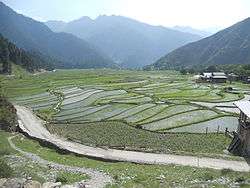
In the central and northern parts of state weather remains moderate hot in summers and very cold and chilly in winter. Snow fall also occurs there in December and January.
This region receives rainfall in both winters and summers. Muzaffarabad and Pattan are among the wettest areas of the state. Throughout most of the region, the average rainfall exceeds 1400 mm, with the highest average rainfall occurring near Muzaffarabad (around 1800 mm). During summer, monsoon floods of the Jhelum and Leepa rivers are common, due to high rainfall and melting snow.
Culture
The culture of Azad Kashmir has many similarities to that of northern Punjabi (Potohar) culture in Punjab province. The natives of Azad Kashmir speak Urdu, Potwari, and the Pahari languages. The Kashmiri language is spoken by hardly 5% of Azad Kashmir's population according to Kashmiri journalist Shujaat Bukhari.[40] Professor Khawaja Abdul Rehman states that the Kashmiri language is on the verge of dying out in the Neelam Valley.[41]
The traditional dress of the women is the shalwar kameez in Pahari style. The shalwar kameez is commonly worn by both men and women. Women use shawl to cover their head and upper body.
Ethnic groups
Azad Jammu and Kashmir consists of almost entirely Muslim population. Most residents of the region are not ethnic Kashmiris.[42] The inhabitants of this region belong to various communities and tribes who share ethnic and linguistic similarities with the people of Northern Punjab. While Urdu is the official language of the region, other languages commonly spoken are Pahari, Gojri and Potohari.[note 3][43] The main communities living in this region are as follows:[44]
- Gurjar-They are an agricultural tribe and are estimated to be the largest community living in Azad Jammu and Kashmir.[44][45][46]
- Jat- They are one of the larger community of AJK and primarily inhabit the Districts of Mirpur, Bhimber and Kotli. A large Mirpuri population lives in the UK and it is estimated that more people of Mirpuri origins are now residing in the UK than in Mirpur district. The district Mirpur retains strong ties with the UK.[44][47]
- Pahari Rajputs- They primarily inhabit the Districts of Muzaffarabad, Bagh, Mirpur, Bhimber and Kotli[44][45]
- Sudhan- They are a large clan living in Poonch, Sudhanoti, Bagh and Kolti districts.[44][45]
- Abbasi- They are a large clan in Azad Jammu and Kashmir and mostly live in Bhag, Jhelum Valley and Muzaffarabad districts. Besides Azad Kashmir, they also inhabit, Abbottabad and upper Potohar Punjab in large numbers.[44][45][46]
- Awan - A clan with significant numbers found in Azad Jammu and Kashmir, living mainly in the Poonch, Jhelum Valley and Muzaffarabad districts. Besides Azad Kashmir they also reside in Punjab and Khyber Pakhtunkhwa in large numbers.[44][45][46]
- Kashmiris - Ethnic Kashmiri populations are found in Neelam Valley and Leepa Valley.[48]
Economy
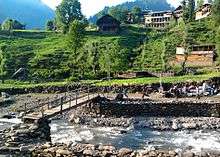
Historically the economy of these areas now called ‘Azad’ Kashmir has been agricultural which meant that land was the main source or mean of production. This means that all food for immediate and long term consumption was produced from land. The produce included various crops, fruits, vegetables etc. Land was also the source of other livelihood necessities such as wood, fuel, grazing for animals which then turned into dairy products. Because of this land was also the main source of revenue for the governments whose primary purpose for centuries was to accumulate revenue.[49]
Agriculture is a major part of Azad Kashmir's economy. Low-lying areas that have high populations grow crops like barley, mangoes, millet, corn (maize), and wheat, and also raise cattle. In the elevated areas that are less populated and more spread-out, forestry, corn, and livestock are the main sources of income. There are mineral and marble resources in Azad Kashmir close to Mirpur and Muzaffarabad. There are also graphite deposits at Mohriwali. There are also reservoirs of low-grade coal, chalk, bauxite, and zircon. Local household industries produce carved wooden objects, textiles, and dhurrie carpets.[1] There is also an arts and crafts industry that produces such cultural goods as namdas, shawls, pashmina, pherans, Papier-mâché, basketry copper, rugs, wood carving, silk and woolen clothing, patto, carpets, namda gubba, and silverware. Agricultural goods produced in the region include mushrooms, honey, walnuts, apples, cherries, medicinal herbs and plants, resin, deodar, kail, chir, fir, maple, and ash timber.[1][25][50]

The migration to UK was accelerated and by the completion of Mangla Dam in 1967 the process of ‘chain migration’ became in full flow. Today, remittances from British Mirpuri community make a critical role in AJK's economy. In the mid-1950s various economic and social development processes were launched in Azad Kashmir. In the 1960s, with the construction of the Mangla Dam in Mirpur District, the Azad Jammu and Kashmir Government began to receive royalties from the Pakistani government for the electricity that the dam provided to Pakistan. During the mid-2000s, a multibillion-dollar reconstruction began in the aftermath of the 2005 Kashmir earthquake.[51]
In addition to agriculture, textiles, and arts and crafts, remittances have played a major role in the economy of Azad Kashmir. One analyst estimated that the figure for Azad Kashmir was 25.1% in 2001. With regard to annual household income, people living in the higher areas are more dependent on remittances than are those living in the lower areas.[52] In the latter part of 2006, billions of dollars for development were mooted by international aid agencies for the reconstruction and rehabilitation of earthquake-hit zones in Azad Kashmir, though much of that amount was subsequently lost in bureaucratic channels, leading to considerable delays in help getting to the most needy. Hundreds of people continued to live in tents long after the earthquake.[51] A land-use plan for the city of Muzaffarabad was prepared by the Japan International Cooperation Agency.
Kashmir as a whole is the one of the most beautiful regions in the world. Some well-known and popular tourist destinations are the following:
- Muzaffarabad, the capital city of Azad Kashmir, is located on the banks of the Jhelum and Neelum rivers. It is 138 kilometres (86 mi) from Rawalpindi and Islamabad. Well-known tourist spots near Muzaffarabad are the Red Fort, Pir Chinassi, Patika, Subri Lake and Awan Patti.
- The Neelam Valley is situated to the north and northeast of Muzaffarabad, The gateway to the valley. The main tourist attractions in the valley are Athmuqam, Kutton, Keran, Changan, Sharda, Kel, Arang Kel and Taobat.
- Rawalakot city is the headquarters of Poonch District and is located 122 kilometres (76 mi) from Islamabad. Tourist attractions in Poonch District are Banjosa Lake, Devi Gali, Tatta Pani, and Toli Pir.
- Bagh city, the headquarters of Bagh District, is 205 kilometres (127 mi) from Islamabad and 100 kilometres (62 mi) from Muzaffarabad. The principal tourist attractions in Bagh District are Bagh Fort, Dhirkot, Sudhan Gali, Ganga Lake, Ganga Choti, Kotla Waterfall, Neela Butt, Danna, Panjal Mastan National Park, and Las Danna.
- The Leepa Valley is located 105 kilometres (65 mi) southeast of Muzaffarabad. It is the most charming and scenic place for tourists in Azad Kashmir.
- Mirpur city is the headquarters of Mirpur District. The main tourist attractions near Mirpur city are the Mangla Lake and Ramkot Fort.
Education
The literacy rate in Azad Kashmir was 62% in 2004, higher than in any region in Pakistan.[53] However, only 2.2% were graduates, compared to the average of 2.9% for Pakistan.[54]
Universities
The following is a list of universities recognised by Higher Education Commission of Pakistan (HEC):[55]
Public universities
- Mirpur University of Science and Technology (MUST)
- University of Azad Jammu & Kashmir
- University of Poonch, Rawalakot
- Women University of Azad Jammu and Kashmir Bagh
- University of Management sciences and Information Technology Kotli
Private universities
Medical colleges
The following is a list of undergraduate medical institutions recognised by Pakistan Medical and Dental Council (PMDC) as of 2013.[56]
Public medical colleges
- Mohtarma Benazir Bhutto Shaheed Medical College
- Azad Jammu Kashmir Medical College
- Poonch Medical College, Rawalakot
Private medical colleges
- Mohiuddin Islamic Medical College, Mirpur (Admission Stopped)
Sports
In terms of sports, football, cricket and volleyball are very popular in Azad Kashmir. Many tournaments are also held throughout the year and in the holy month of Ramazan night time floodlit tournaments are also organised.
- Azad Kashmir has a T20 cricket team in Pakistan's T20 domestic tournament
Mirpur has a cricket stadium (Quaid-e-Azam Stadium) which has been taken over by the Pakistan Cricket Board for renovation to bring it up to International standards. There is also a cricket stadium in Muzaffarabad with the capacity of 8,000 people. This stadium has hosted 8 matches of Inter-District Under 19 Tournament 2013.
There are also registered football clubs namely, Pilot Football Club, Youth Football Club, Kashmir National FC and Azad Super FC.
Gallery
-

Kotla, Bagh Azad Kashmir
-
Mangla Dam, outside of Mirpur
-
Typical houses in Mirpur
-

Rawalakot bazaar
-

Neelam Valley
See also
Notes
- ↑ The Indian government and Indian sources refer to Azad Kashmir as "Pakistan-occupied Kashmir" ("PoK")[6] or "Pakistan-held Kashmir" (PHK),[7] sometimes in conjunction with other areas of Kashmir under Pakistani control. "Pakistan-administered Kashmir" and "Pakistan-controlled Kashmir"[8][9] are used by neutral sources. Conversely, Pakistani sources call the territory under Indian control "Indian-Occupied Kashmir" ("IOK") or "Indian-Held Kashmir" ("IHK").[6]
- ↑ Officially, Mirpur and Poonch districts were in the Jammu province of the state and Muzaffarabad was in the Kashmir province. All three provinces spoke languages related to Punjabi, not the Kashmiri language spoken in the Kashmir Valley.[15]
- ↑ Snedden (2013, p. 176): On p. 29, the census report states that Urdu is the official language of the Government of Azad Kashmir, with Kashmiri, Pahari, Gojri, Punjabi, Kohistani, Pushto and Sheena `frequently spoken in Azad Kashmir'. Yet, when surveyed about their `Mother Tongue', Azad Kashmiris' choices were limited to selecting from Pakistan's major languages: Urdu, Punjabi, Sindhi, Pushto, Balochi, Saraiki and `Others'; not surprisingly, 2.18 million of Azad Kashmir's 2.97 million people chose `Others'.
References
- 1 2 3 4 5 6 "Azad Kashmir" at britannica.com
- ↑ "Kashmir profile". BBC. November 26, 2014. Archived from the original on July 24, 2015. Retrieved July 24, 2015.
- 1 2 Policy Perspectives. Institute of Policy Studies. 2006.
Azad Kashmir declared self-government on October 24, 1947
- ↑ Richard M. Bird; François Vaillancourt (4 December 2008). Fiscal Decentralization in Developing Countries. Cambridge University Press. pp. 127–. ISBN 978-0-521-10158-5.
- ↑ "Territorial limits". Herald. May 7, 2015. Archived from the original on July 24, 2015. Retrieved July 24, 2015.
These are self-ruled autonomous regions.
- 1 2 Snedden 2013, pp. 2-3.
- ↑ Chandra, Bipan; Mukherjee, Aditya; Mukherje, Mridula (2008). India since Independence. Penguin Books India. p. 416. ISBN 0143104098.
- ↑ Bose, Sumantra (2009). Contested lands: Israel-Palestine, Kashmir, Bosnia, Cyprus and Sri Lanka. Harvard University Press. p. 193. ISBN 0674028562.
- ↑ Behera, Navnita Chadha (2007). Demystifying Kashmir. Pearson Education India. p. 66. ISBN 8131708462.
- ↑ "Underdevelopment in AJK". www.thenews.com.pk. Retrieved 2016-06-18.
- ↑ "Education emergency: AJK leading in enrolment, lagging in quality - The Express Tribune". The Express Tribune. 2013-03-26. Retrieved 2016-06-18.
- ↑ "The J&K conflict: A Chronological Introduction". India Together. Retrieved 2010-06-05.
- 1 2 Britannica Concise Encyclopedia. "Kashmir (region, Indian subcontinent) – Britannica Online Encyclopedia". Encyclopædia Britannica. Retrieved 2010-06-05.
- ↑ Bose 2003, pp. 32-33.
- ↑ Behera, Navnita Chadha (2007), Demystifying Kashmir, Pearson Education India, p. 29, ISBN 8131708462
- ↑ Snedden 2013, p. 59.
- ↑ Snedden 2013, p. 61.
- ↑ http://www.bbc.com/news/10537286
- ↑ Bose 2003, pp. 35-36.
- ↑ Prem Shankar Jha. "Grasping the Nettle". South Asian Journal. Archived from the original on May 16, 2012.
- ↑ "UN resolution 47". Retrieved 11 September 2012.
- ↑ "UNCIP Resolution of August 13, 1948 (S/1100) – Embassy of India, Washington, D.C.". Archived from the original on October 13, 2007.
- ↑ "UNMOGIP: United Nations Military Observer Group in India and Pakistan". Archived from the original on May 14, 2008.
- ↑ "How free is Azad Kashsmir".
- 1 2 3 "Azad Jammu and Kashmir – Introduction". Archived from the original on Sep 27, 2007. Retrieved June 22, 2010.
- ↑ http://ajk.gov.pk/history.php
- ↑ Adams, Brad. "Pakistan: 'Free Kashmir' Far From Free". Human Rights Watch.
- ↑ Snedden, Christopher (2013). Kashmir-The Untold Story. Harper Collins Publishers India. ISBN 9789350298985.
- ↑ Snedden, Christopher (2013). Kashmir-The Untold Story. Harper Collins Publishers India. ISBN 9789350298985.
- ↑ Snedden, Christopher (2013). Kashmir-The Untold Story. Harper Collins Publishers India. ISBN 9789350298985.
- ↑ Bose, Sumantra (2003), Kashmir: Roots of Conflict, Paths to Peace, Harvard University Press, p. 100, ISBN 0-674-01173-2
- ↑ Snedden, Christopher (2013). Kashmir-The Untold Story. Harper Collins Publishers India. ISBN 9789350298985.
- ↑ Snedden, Christopher (2013). Kashmir-The Untold Story. Harper Collins Publishers India. ISBN 9789350298985.
- ↑ http://ajk.gov.pk/history.php
- ↑ "Pakistan to observe Kashmir Solidarity Day today". The Hindu. February 5, 2007. Retrieved 2008-02-05.
- ↑ "Kashmir Day being observed today". The News International. February 5, 2008. Retrieved 2008-02-05.
- ↑ "Administrative Setup.". ajk.gov.pk. Archived from the original on April 9, 2010. Retrieved May 17, 2010.
- ↑ "Azad Kashmir". City Population. Retrieved 6 May 2015.
- ↑ http://www.pakistanalpine.com/sarwali-peak
- ↑ Bukhari, Shujaat (14 June 2011). "The other Kashmir". The Hindu.
- ↑ "Up North: Call for exploration of archaeological sites". Express Tribune. 5 June 2015.
- ↑ Snedden, Christopher (2015). Understanding Kashmir and Kashmiris. Oxford University Press. ISBN 9781849046220.
- ↑ http://www-01.sil.org/asia/ldc/parallel_papers/tariq_rahman.pdf
- 1 2 3 4 5 6 7 Snedden 2013, Role of Biradaries (pp. 128-133)
- 1 2 3 4 5 http://www.erra.pk/Reports/KMC/RawlakotProfile200907.pdf
- 1 2 3 http://www.erra.pk/Reports/KMC/BaghProfile200907.pdf
- ↑ Moss, Paul (November 30, 2006). "South Asia | The limits to integration". BBC News. Retrieved 2010-06-05.
- ↑ Snedden, Christopher (2015). Understanding Kashmir and Kashmiris. Oxford University Press. ISBN 9781849046220.
- ↑ "History of Planning & Development Department in AJK".
- ↑ "Azad Jammu & Kashmir – Tourism". Archived from the original on May 29, 2008. Retrieved June 22, 2010.
- 1 2 Naqash, Tariq (October 1, 2006). "'Rs1.25 trillion to be spent in Azad Kashmir': Reconstruction in quake-hit zone". Dawn. Muzaffarabad.
- ↑ Abid Qaiyum Suleri; Kevin Savage. "Remittances in crises: a case study from Pakistan" (PDF). Retrieved 2010-06-05.
- ↑ "'Literacy Rate in Azad Kashmir nearly 62 pc'". Pakistan Times. MUZAFFARABAD (Azad Kashmir). September 27, 2004. Archived from the original on February 27, 2005.
- ↑ Hasan, Khalid (April 17, 2005). "Washington conference studies educational crisis in Pakistan". Daily Times. Washington. Archived from the original on June 7, 2011.
Grace Clark told the conference that only 2.9% of Pakistanis had access to higher education.
- ↑ "Our Institutions". Higher Education Commission of Pakistan. Retrieved 19 November 2013.
- ↑ "Recognized medical colleges in Pakistan". Pakistan Medical and Dental Council. Retrieved 19 November 2013.
- Sources
- Bose, Sumantra (2003). Kashmir: Roots of Conflict, Paths to Peace. Harvard University Press. ISBN 0-674-01173-2.
- Snedden, Christopher (2013) [first published as The Untold Story of the People of Azad Kashmir, 2012], Kashmir: The Unwritten History, HarperCollins India, ISBN 9350298988
Further reading
- Mathur, Shubh (2008). "Srinagar-Muzaffarabad-New York: A Kashmiri Family's Exile". In Roy, Anjali Gera; Bhatia, Nandi. Partitioned Lives: Narratives of Home, Displacement and Resettlement. Pearson Education India. ISBN 9332506205.
- Schoefield, Victoria (2003) [First published in 2000]. Kashmir in Conflict. London and New York: I. B. Taurus & Co. ISBN 1860648983.
External links
| Wikimedia Commons has media related to Azad Kashmir. |
 |
Khyber Pakhtunkhwa | Gilgit–Baltistan |  | |
| |
| |||
| ||||
| | ||||
| Punjab |


.jpg)

.jpg)

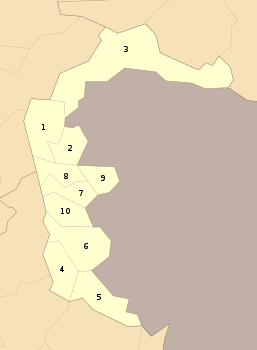

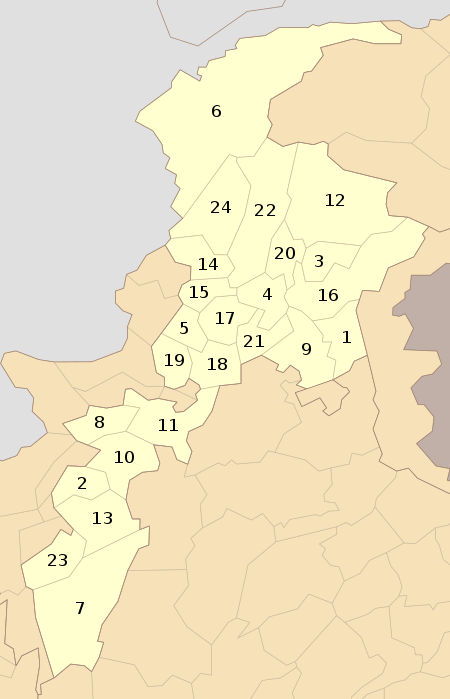
_Districts.svg.png)


